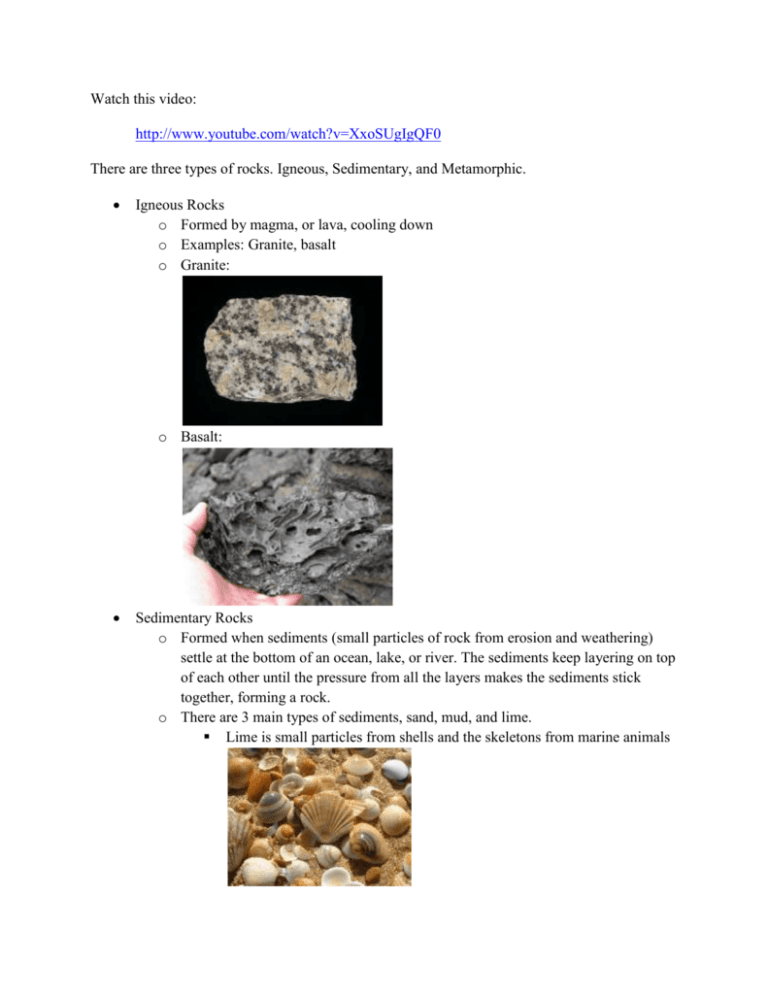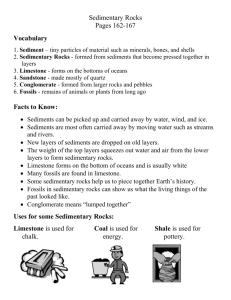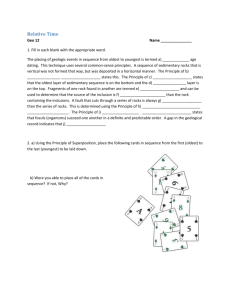File
advertisement

Watch this video: http://www.youtube.com/watch?v=XxoSUgIgQF0 There are three types of rocks. Igneous, Sedimentary, and Metamorphic. Igneous Rocks o Formed by magma, or lava, cooling down o Examples: Granite, basalt o Granite: o Basalt: Sedimentary Rocks o Formed when sediments (small particles of rock from erosion and weathering) settle at the bottom of an ocean, lake, or river. The sediments keep layering on top of each other until the pressure from all the layers makes the sediments stick together, forming a rock. o There are 3 main types of sediments, sand, mud, and lime. Lime is small particles from shells and the skeletons from marine animals When sand is compressed together it forms sandstone. Example: Lake Powell, Grand Canyon When mud is compressed together it forms shale When lime (small particles from skeletons of marine animals and shells) is compressed together it forms limestone Metamorphic Rocks o Formed when igneous or sedimentary rocks come under extreme heat and pressure Press your hands together as hard as you can. Can you feel the pressure and the heat? Rub your hands together. Can you feel the heat? Your hands are like the earth’s crust rubbing together to make extreme heat and pressing down on the rocks to create extreme pressure. When igneous or sedimentary rocks come under extreme heat and pressure they become metamorphic rocks When granite (which is an igneous rock) comes under extreme heat and pressure it becomes gneiss (pronounced the same way as the word “nice”) When sandstone (which is a sedimentary rock) comes under extreme heat and pressure it becomes quartzite When shale (sedimentary) comes under extreme heat and pressure it becomes slate When limestone comes under extreme heat and pressure it becomes marble This flow chart shows the rock cycle. Extreme heat and pressure Igneous Rocks Formed by cooling magma/lava Example: Granite Cooling magama Weathering and erosion Sedimentary Rocks Formed from sediments that have sunk to the bottom of an ocean, lake, or river Sand Sandstone Mud Shale Lime (particles of shells and bones of marine animals) Limestone Extreme heat and pressure Weathering and erosion Cooling magma Metamorphic Rocks Formed when igneous or sedimentary rocks come under extreme heat and pressure Granite Gneiss Sandstone Quartzite Shale Slate Limestone Marble This chart will be on your test. The first column lists the 3 types of sediments we discussed, sand, mud, and lime The second column lists what kind of sedimentary rocks those sediments create. o Sand turns into sandstone, mud turns into shale, and lime turns into limestone The third column lists what happens to those sedimentary rocks when they come under extreme heat and pressure (turning into metamorphic rocks) o Sandstone becomes quartzite, shale becomes slate, and limestone becomes marble Sediments Sand Sedimentary Rocks Sandstone Metamorphic Rocks Quartzite Mud Shale Slate Lime Limestone Marble On your test the chart will look like this and you will have to fill in the missing spots: Sediments Sedimentary Rocks Metamorphic Rocks Quartzite Shale Lime Check out this website and power point presentation for more information and help: http://www.mineralogy4kids.org/rock-cycle https://docs.google.com/presentation/d/1dnaYrVImHWU3m__yTp7NMnuwwaED0pnYPISPHu EypZE/edit?usp=sharing








